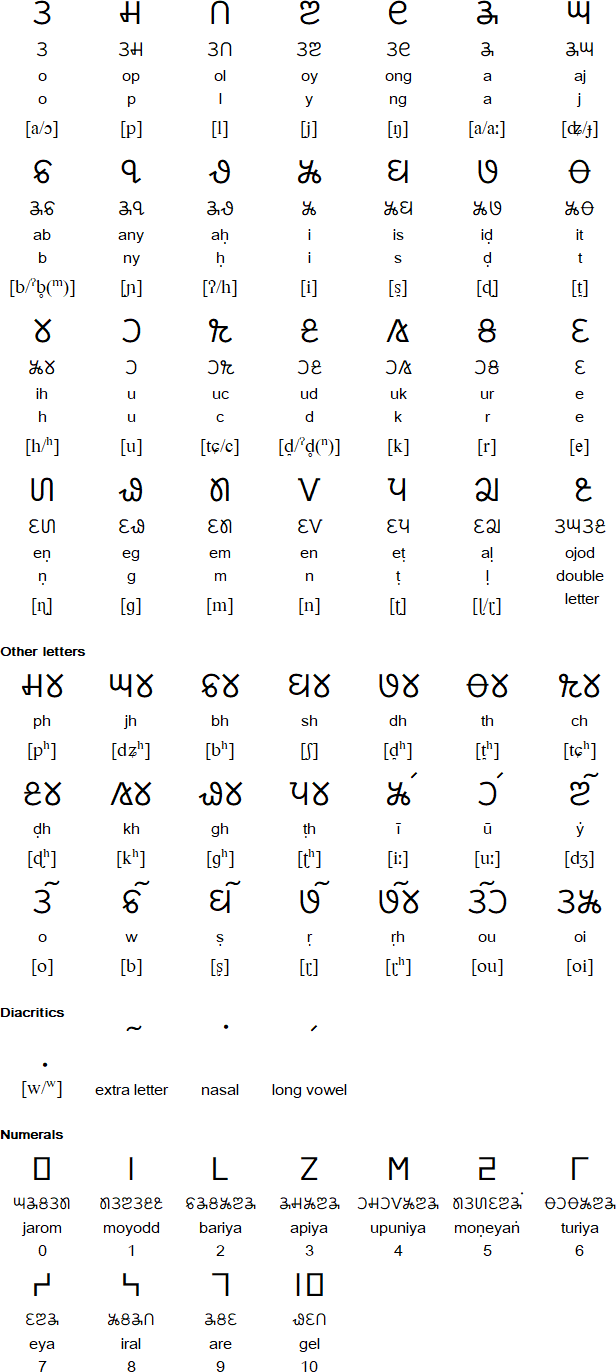The Mundari Bani alphabet was created by Rohidas Singh Nag (1934-2012), a Mundari linguist from the Mayurbhanj state of Odisha, as a way to write the Mundari language. He started working on it in 1949 while in primary school, and had finished it by 1953. He simplified the alphabet in 1980 by reducing the number of letters from 35 to 27, and he further reformed it in 2008 with help from Bharat Munda Samaj and Mundari Samaj Sanwar Jamda. A number of books have been published in this script.
Mundari Bani is also known as Mundari Bani Hisir, Nag Mundari or the Mundari alphabet. It is used to some extent in literature, education and computing in Odisha, and was added to Unicode in 2021. Mundari is also written with the Devanagari, Odia, Bengali and Latin scripts.

Download a alphabet chart for Mundari Bani (Excel)
Download Mundari Bani fonts.
See also: https://fonts.google.com/noto/specimen/Noto+Sans+Nag+Mundari

Soben hoḷo kokew manarng oḍoḥ oktiyar koreyag paiti babot re jonom jorongete adanad oḍog borabori namakana. Inkugke seṇa oḍog jīw peḷeg jī ureyaḥ enemko namakana oḍoḥ inkuḥ loḥte hageya boya leka jagar bakatiñaḥ.
All human beings are born free and equal in dignity and rights. They are endowed with reason and conscience and should act towards one another in a spirit of brotherhood.
(Article 1 of the Universal Declaration of Human Rights)
A video about the Mundari Bani alphabet
Details provided by Biswajit Mandal (biswajitmandal[dot]bm90[at]gmail[dot]com), Nandalal Singh, Birbal Singh and Gourahari Singh
Information about Mundari | Mundari Bani alphabet | Numbers
Information about Mundari Bani
https://en.wikipedia.org/wiki/Mundari_Bani
https://www.endangeredalphabets.net/mundari-bani/
http://en.wikipedia.org/wiki/Mundari_language
https://r12a.github.io/scripts/nagm/unr
https://r12a.github.io/scripts/nagm/block
Online Mundari Bani keyboard
https://languagetools-153419.appspot.com/unr/
A-chik Tokbirim, Adinkra, ADLaM, Armenian, Avestan, Avoiuli, Bactrian, Bassa (Vah), Beitha Kukju, Beria (Zaghawa), Borama / Gadabuursi, Carian, Carpathian Basin Rovas, Chinuk pipa, Chisoi, Coorgi-Cox, Coptic, Cyrillic, Dalecarlian runes, Elbasan, Etruscan, Faliscan, Fox, Galik, Georgian (Asomtavruli), Georgian (Nuskhuri), Georgian (Mkhedruli), Glagolitic, Global Alphabet, Gothic, Greek, Hurûf-ı munfasıla, Irish (Uncial), Kaddare, Kayah Li, Khatt-i-Badíʼ, Khazarian Rovas, Koch, Korean, Latin, Lepontic, Luo Lakeside Script, Lycian, Lydian, Manchu, Mandaic, Mandombe, Marsiliana, Medefaidrin, Messapic, Mongolian, Mro, Mundari Bani, Nag Chiki, Naasioi Otomaung, N'Ko, North Picene, Novo Tupi, Nyiakeng Puachue Hmong, Odùduwà, Ogham, Old Church Slavonic, Oirat Clear Script, Ol Chiki (Ol Cemet' / Santali), Old Italic, Old Nubian, Old Permic, Ol Onal, Orkhon, Osage, Oscan, Osmanya (Somali), Pau Cin Hau, Phrygian, Pollard script, Runic, Székely-Hungarian Rovás (Hungarian Runes), South Picene, Sutton SignWriting, Sunuwar, Tai Viet, Tangsa, Todhri, Toto, Umbrian, (Old) Uyghur, Wancho, Yezidi, Zoulai
Page last modified: 13.02.24
[top]
You can support this site by Buying Me A Coffee, and if you like what you see on this page, you can use the buttons below to share it with people you know.

If you like this site and find it useful, you can support it by making a donation via PayPal or Patreon, or by contributing in other ways. Omniglot is how I make my living.
Note: all links on this site to Amazon.com, Amazon.co.uk
and Amazon.fr
are affiliate links. This means I earn a commission if you click on any of them and buy something. So by clicking on these links you can help to support this site.
[top]